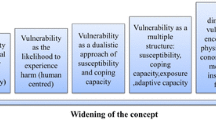Abstract
Located in the eastern part of Tanzania, coastal zones are recognized as hotspots of global biodiversity. But for several years now, they have been subjected to many pressures of a natural and human nature. Forest degradation occurs mainly in protected areas close to cities. Thus, the two forest reserves of Pugu and Kazimzumbwi are the most threatened forests on the Tanzanian coast. Thus, this study is intended to assess the expansion of vulnerability around reserves under anthropogenic pressures using multi-criteria analysis and biophysical and socio-economic data. The results of the multi-criteria analysis show that the risk of forest degradation remains very high in the eastern part of the reserves due to the proximity of the towns of Pugu and Kisarawe. There is also the import share of the proximity of communication axes such as the main road to the east of the reserves and the railroad to the north in the vulnerability process.
Access this chapter
Tax calculation will be finalised at checkout
Purchases are for personal use only
Similar content being viewed by others
References
Living forests report: chapter 5_saving forests at risk. WWF, Gland, Switzerland, pp. 31–32 (2015)
Strömquist, L., Backéus, I.: Integrated landscape analyses of change of miombo woodland in tanzania and its implication for environment and human livelihood. Geogr. Ann. Ser. A Phys. Geogr. 91(1), 31–45 (2009)
Holden, S.: Century of technological Change and deforestation in the miombo Woodlands of northern Zambia. In: Angelsen, A., Kaimowitz, D. (eds.) Agricultural Technologies and Tropical Deforestation. CAB International, Wallingford (2001)
Bandyopadhyay, S., Shyamsundar, P., Baccini, A.: Forests, biomass use and poverty. Ecol. Econ. 70, 2461–2471 (2011)
WWF miombo ecoregion Programme: Miombo Ecoregion “Home of the Zambezi”: Conservation Strategy 2011–2020, Harare, Zimbabwe (2012)
Hansen, M.C., et al.: Science 342, 850–853 (2013)
Bugess, N.D., Cordeiro, N., Doggart, N., Fjeldså, J., Howell, K.M., Kilahama, F., Loader, S.P., Lovett, J.C., Mengon, M., Moyer, D., Nashanda, E., Perkin, A., Stanley, W.T., Stuart, S.: The biological importance of the Eastern Arc Mountains of Tanzania and Kenya. Biol. Cons. 134, 209–231 (2007)
Mdemu, M., Kashaigili, J.J., Lupala, J., Levira, P., Liwenga, E., Nduganda, A., Mwakapuja, F.: Dynamics of land use and land cover changes in the Pugu and Kazimzumbwi Forest Reserves, pp. 71–72 (2012)
White, F.: The vegetation of Africa. A descriptive memoir to accompany the UNESCO/AETFAT/UNSO vegetation map of Africa. Natural Resources Research XX. Unesco Paris, 356 p. (1983)
Howell, K.M.: Pugu Forest Reserve: biological values and development. Af. J. Ecol 19, 73–81 (1981). https://doi.org/10.4000/vertigo.5356. http://faostat.fao.org/default.aspx
Boussougou Boussougou, G.: Vulnérabilité des paysages forestiers en relation avec les activités humaines et la variabilité climatique en Tanzanie : Analyse prospective des dynamiques de l’occupation du sol des réserves forestières de Pugu et de Kazimzumbwi. Géographie. Université de la Réunion, pp. 109–112 (2017)
URT: The National Energy Policy. United Republic of Tanzania (2015)
Daoud, B.H.: Intégration de l’analyse multicritère dans les systèmes d’information géographique : développement d’un prototype MapInfo-Electre. Thèse de magister, Centre national des techniques spatiales, Arzew (Algérie), 93 p. (1997)
Saaty, T.L.: A scaling method for priorities in hierarchical structures. J. Math. Psychol. 15, 234–281 (1977)
Kouamé, K.J., Deh, S.K., Anani, A.T., Jourda, J.P., Biemi, J.: Gestion des déchets solides dans le District d’Abidjan (Sud de la Côte d’Ivoire): Apports d’un SIG et des méthodes d’analyse multicritère. In: Conférence francophone ESRI, Versailles de 10 au 11 octobre 2007
Kêdowide, C.M.G.: Modélisation géomatique par évaluation multicritère pour la prospection de sites d’agriculture à Ouagadougou. VertigO – La revue en sciences de l’environnement 10(2), 20 (2010). http://vertigo.revues.org/10368
Bensaïd, A., Barki, M., Talbi, O., Benhanifia, K., Mendas, A.: L’analyse multicritère comme outil d’aide à la décision pour la localisation spatiale des zones à fortes pression anthropique: le cas du département de Naama en Algérie. Revue Télédétection 7(1), 359–371 (2007)
Acknowledgement
This article is taken from Guy Boussougou Boussougou’s thesis defended in 2017 in subparts 3.2 and 3.3 of chapter 3.
Author information
Authors and Affiliations
Corresponding author
Editor information
Editors and Affiliations
Rights and permissions
Copyright information
© 2018 Springer International Publishing AG, part of Springer Nature
About this paper
Cite this paper
Boussougou Boussougou, G., Brou, Y.T., Valimba, P. (2018). Vulnerability of Pugu and Kazimzumbwi Forest Reserves Under Anthropogenic Pressure in Southeast Tanzania. In: Gervasi, O., et al. Computational Science and Its Applications – ICCSA 2018. ICCSA 2018. Lecture Notes in Computer Science(), vol 10961. Springer, Cham. https://doi.org/10.1007/978-3-319-95165-2_16
Download citation
DOI: https://doi.org/10.1007/978-3-319-95165-2_16
Published:
Publisher Name: Springer, Cham
Print ISBN: 978-3-319-95164-5
Online ISBN: 978-3-319-95165-2
eBook Packages: Computer ScienceComputer Science (R0)




